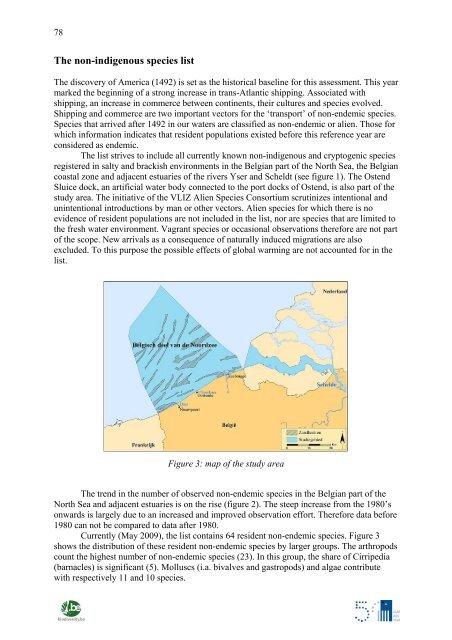Science Facing Aliens - Invasive Alien Species in Belgium - Belgian ...
Science Facing Aliens - Invasive Alien Species in Belgium - Belgian ...
Science Facing Aliens - Invasive Alien Species in Belgium - Belgian ...
You also want an ePaper? Increase the reach of your titles
YUMPU automatically turns print PDFs into web optimized ePapers that Google loves.
78<br />
The non-<strong>in</strong>digenous species list<br />
The discovery of America (1492) is set as the historical basel<strong>in</strong>e for this assessment. This year<br />
marked the beg<strong>in</strong>n<strong>in</strong>g of a strong <strong>in</strong>crease <strong>in</strong> trans-Atlantic shipp<strong>in</strong>g. Associated with<br />
shipp<strong>in</strong>g, an <strong>in</strong>crease <strong>in</strong> commerce between cont<strong>in</strong>ents, their cultures and species evolved.<br />
Shipp<strong>in</strong>g and commerce are two important vectors for the ‘transport’ of non-endemic species.<br />
<strong>Species</strong> that arrived after 1492 <strong>in</strong> our waters are classified as non-endemic or alien. Those for<br />
which <strong>in</strong>formation <strong>in</strong>dicates that resident populations existed before this reference year are<br />
considered as endemic.<br />
The list strives to <strong>in</strong>clude all currently known non-<strong>in</strong>digenous and cryptogenic species<br />
registered <strong>in</strong> salty and brackish environments <strong>in</strong> the <strong>Belgian</strong> part of the North Sea, the <strong>Belgian</strong><br />
coastal zone and adjacent estuaries of the rivers Yser and Scheldt (see figure 1). The Ostend<br />
Sluice dock, an artificial water body connected to the port docks of Ostend, is also part of the<br />
study area. The <strong>in</strong>itiative of the VLIZ <strong>Alien</strong> <strong>Species</strong> Consortium scrut<strong>in</strong>izes <strong>in</strong>tentional and<br />
un<strong>in</strong>tentional <strong>in</strong>troductions by man or other vectors. <strong>Alien</strong> species for which there is no<br />
evidence of resident populations are not <strong>in</strong>cluded <strong>in</strong> the list, nor are species that are limited to<br />
the fresh water environment. Vagrant species or occasional observations therefore are not part<br />
of the scope. New arrivals as a consequence of naturally <strong>in</strong>duced migrations are also<br />
excluded. To this purpose the possible effects of global warm<strong>in</strong>g are not accounted for <strong>in</strong> the<br />
list.<br />
Figure 3: map of the study area<br />
The trend <strong>in</strong> the number of observed non-endemic species <strong>in</strong> the <strong>Belgian</strong> part of the<br />
North Sea and adjacent estuaries is on the rise (figure 2). The steep <strong>in</strong>crease from the 1980’s<br />
onwards is largely due to an <strong>in</strong>creased and improved observation effort. Therefore data before<br />
1980 can not be compared to data after 1980.<br />
Currently (May 2009), the list conta<strong>in</strong>s 64 resident non-endemic species. Figure 3<br />
shows the distribution of these resident non-endemic species by larger groups. The arthropods<br />
count the highest number of non-endemic species (23). In this group, the share of Cirripedia<br />
(barnacles) is significant (5). Molluscs (i.a. bivalves and gastropods) and algae contribute<br />
with respectively 11 and 10 species.


